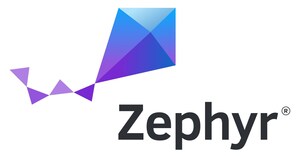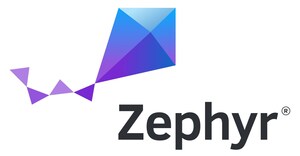SAN FRANCISCO, Oct. 8, 2019 /PRNewswire/ -- The Zephyr™ Project, an open source project at the Linux Foundation that aims to build a secure and flexible real-time operating system (RTOS) for the Internet of Things (IoT) announces its growing ecosystem with the addition of Eclipse IoT and the move up for long-time member Oticon to Platinum member. Additionally, the project announces the release of Zephyr 2.0.0 and that several popular developer boards are now shipping with Zephyr including Nordic Semiconductor's Nordic Thingy91 and Adafruit's Actinius Icarus.
In today's technology landscape, fragmentation is the biggest challenge. Developers have a wide range of choices for platforms, boards and components and many of those don't and can't connect with each other. Zephyr offers a small memory footprint and a secure and flexible RTOS that extends functionality of IoT devices. It is a customizable, embedded open source platform that can be built for multiple hardware architectures with safety and security.
A Diverse and Active Community
Zephyr Project member companies include Antmicro, Foundries.io, Intel, Linaro, Nordic Semiconductor, NXP®, SiFive, Synopsys and Texas Instruments among others. Today, the project welcomes the Eclipse IoT as a new member and Oticon, which has been an active member for three years, recently upgraded to Platinum.
"The Eclipse Foundation's IoT Working Group is home to many open source projects relevant to embedded Linux and Zephyr developers," said Frédéric Desbiens, Program Manager for IoT and Edge Computing for the Eclipse Foundation. "Zephyr is one of the platforms supported by the Eclipse MRAA and Eclipse UPM abstraction libraries, which make constrained device applications device and OS independent. Moreover, Zephyr-based devices can integrate easily in IoT architectures leveraging the rich set of Eclipse IoT components, such as Eclipse Leshan for device management and Eclipse hawkBit for software updates. At the Eclipse Foundation, we think that IoT developers should absolutely consider the Zephyr RTOS when designing solutions that involve constrained devices. Zephyr has a lot to offer: vendor-neutral governance, a long term support (LTS) branch, and its emphasis on security."
"At Oticon, we are pleased to have upgraded our Zephyr membership level to platinum," said Finn Möhring, senior vice president of R&D at Oticon. " We cherish the partnership with Zephyr being a professional open source community that supports us building world-class connectivity solutions for our hearing aids. Having launched the world's first internet-connected hearing aids, we are excited to be part of the unique IoT ecosystem and we value the inspiration we get from the Zephyr ecosystem when developing solutions that help people with hearing loss connect their daily, modern life."
"We are excited about the growth of the Zephyr ecosystem," said Kate Stewart, Senior Director of Strategic Programs for the Linux Foundation.
"It's a vibrant and diverse community driven to create an open source RTOS that fuels adoption and innovation. Their dedication has made a huge impact in the market and we're now seeing many more boards planned for shipping with Zephyr and more products based on Zephyr."
Zephyr 2.0.0
In April, the Zephyr project launched the 1.14 LTS release, which offers vendors a customizable operating system that supports product longevity, security and interoperability. Since then, the community has hit several additional milestones with more than 500 active contributors. In fact, last month Zephyr had 900 commits - which equates to 30 commits a day, or more than 1 commit an hour - to help prepare the newly launched Zephyr 2.0.0.
Key enhancements of Zephyr RTOS version 2.0.0 include new or enhanced support for:
- Both 32- and 64-bit architectures;
- ARM Cortex-R Architecture;
- SOCKS5 proxy, an Internet protocol that exchanges network packets between a client and server through a proxy server;
- Point-to-Point Protocol (PPP), a data link layer (layer 2) communications protocol used to establish a direct connection between two nodes; and
- UpdateHub, an end-to-end solution for large scale over-the-air device updates.
In addition, the first update of LTS - Zephyr 1.14.1 is being released, which provides a stable base for product development.
"The delivery of these two releases demonstrates the level of commitment from the Zephyr Project and its members to support a stable LTS base, as well as introduce new features and enhancements intended to make IoT development easier," says Maureen Helm, senior software engineer at NXP and Technical Steering Committee Chair of the Zephyr Project. "These releases further solidify Zephyr OS as a leader in open source embedded development."
Learn more about the Zephyr 2.0 technical details in this blog.
Technical Momentum
Nordic Semiconductor recently launched Nordic Thingy 91, an easy-to-use battery-operated prototyping platform for cellular IoT using LTE-M, NB-IoT and GPS. It's ideal for creating Proof-of-Concept (PoC), demos and initial prototypes in your IoT development phase. It is packed with a multitude of sensors for motion, impact, air quality and includes a nRF52840 that can be used to connect to short range networks like Bluetooth LE, Thread or Zigbee. The nRF Connect SDK for cellular IoT is built with the Zephyr RTOS and features applications and examples that can be extended to build complete connected products. Using kconfig, the right combination of high level communication protocols and supporting drivers available in Zephyr can be included in any application.
Zephyr supports more than 160 board configurations spanning 10 architectures. For the complete list, visit the Zephyr Github page.
In addition to the increased board support, Zephyr technical momentum also includes being featured in a few getting started and study guides that offer development tips for creating open source solutions.
The Bluetooth LE Developer Study Guide, created by the Bluetooth Special Interest Group (SIG), uses Zephyr to help developers learn about Bluetooth Mesh from a variety of perspectives and gives them a range of projects they can leverage, whether they're a smartphone developer or an embedded software engineer. Additionally, Zephyr v1.14.1 LTS Host and Mesh subsystems are now Bluetooth qualified. This means that a developer working on a Bluetooth product based on Zephyr v1.14.1 LTS release can use the available QDIDs to simplify their Bluetooth qualifications.
The RISC-V Getting Started Guide, in partnership with Antmicro, is a new resource intended to help members of the RISC-V Foundation and the Zephyr communities quickly get started using the RTOS on the RISC-V architecture.
"At Antmicro, we strongly advocate openness and interoperability. As supporters and active contributors to Zephyr, we are happy to see the ecosystem expanding and look forward to the technology synergies offered by Zephyr and RISC-V on many fronts, as stressed in the RISC-V Getting Started Guide we kickstarted," said Michael Gielda, VP Business Development at Antmicro.
The Zephyr Project will be on-site at the Linux Foundation's Embedded Linux Conference Europe in Lyon, France on October 28-30 with 13 presentations and a Mini-Summit. Learn more about the sessions and add them to your schedule: https://www.zephyrproject.org/event/embedded-linux-conference-europe/.
To learn more about the products that use Zephyr RTOS, visit the Zephyr website and blog.
About the Zephyr™ Project
The Zephyr Project is a small, scalable real-time operating system for use on resource-constrained systems supporting multiple architectures. To learn more, please visit www.zephyrproject.org.
About the Linux Foundation
Founded in 2000, the Linux Foundation is supported by more than 1,000 members and is the world's leading home for collaboration on open source software, open standards, open data, and open hardware. Linux Foundation's projects are critical to the world's infrastructure including Linux, Kubernetes, Node.js, and more. The Linux Foundation's methodology focuses on leveraging best practices and addressing the needs of contributors, users and solution providers to create sustainable models for open collaboration. For more information, please visit us at linuxfoundation.org.
The Linux Foundation has registered trademarks and uses trademarks. For a list of trademarks of The Linux Foundation, please see our trademark usage page: https://www.linuxfoundation.org/trademark-usage. Linux is a registered trademark of Linus Torvalds.
Media Contact:
Maemalynn Meanor
(602) 541-0356
[email protected]
SOURCE The Zephyr Project

Related Links
WANT YOUR COMPANY'S NEWS FEATURED ON PRNEWSWIRE.COM?
Newsrooms &
Influencers
Digital Media
Outlets
Journalists
Opted In





Share this article